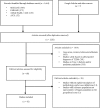Estimating the prevalence, hospitalisation and mortality from type 2 diabetes mellitus in Nigeria: a systematic review and meta-analysis
- PMID: 28495817
- PMCID: PMC5566593
- DOI: 10.1136/bmjopen-2016-015424
Estimating the prevalence, hospitalisation and mortality from type 2 diabetes mellitus in Nigeria: a systematic review and meta-analysis
Abstract
Background: There is not yet a comprehensive evidence-based epidemiological report on type 2 diabetes mellitus (T2DM) in Nigeria. We aimed to estimate country-wide and zonal prevalence, hospitalisation and mortality rates of T2DM in Nigeria.
Methods: We searched MEDLINE, EMBASE, Global Health, Africa Journals Online (AJOL) and Google Scholar for population and hospital-based studies on T2DM in Nigeria. We conducted a random-effects meta-analysis on extracted crude estimates, and applied a meta-regression epidemiological model, using the United Nations demographics for Nigeria in 1990 and 2015 to determine estimates of diabetes in Nigeria for the two years.
Results: 42 studies, with a total population of 91 320, met our selection criteria. Most of the studies selected were of medium quality (90.5%). The age-adjusted prevalence rates of T2DM in Nigeria among persons aged 20-79 years increased from 2.0% (95% CI 1.9% to 2.1%) in 1990 to 5.7% (95% CI 5.5% to 5.8%) in 2015, accounting for over 874 000 and 4.7 million cases, respectively. The pooled prevalence rate of impaired glucose tolerance was 10.0% (95% CI 4.5% to 15.6%), while impaired fasting glucose was 5.8% (95% CI 3.8% to 7.8%). Hospital admission rate for T2DM was 222.6 (95% CI 133.1 to 312.1) per 100 000 population with hyperglycaemic emergencies, diabetic foot and cardiovascular diseases being most common complications. The overall mortality rate was 30.2 (95% CI 14.6 to 45.8) per 100 000 population, with a case fatality rate of 22.0% (95% CI 8.0% to 36.0%).
Conclusion: Our findings suggest an increasing burden of T2DM in Nigeria with many persons currently undiagnosed, and few known cases on treatment.
Keywords: Nigeria; complications; diabetes; epidemiology; mortality; prevalence.
© Article author(s) (or their employer(s) unless otherwise stated in the text of the article) 2017. All rights reserved. No commercial use is permitted unless otherwise expressly granted.
Conflict of interest statement
Competing interests: None declared.
Figures







Similar articles
-
Dipeptidyl-peptidase (DPP)-4 inhibitors and glucagon-like peptide (GLP)-1 analogues for prevention or delay of type 2 diabetes mellitus and its associated complications in people at increased risk for the development of type 2 diabetes mellitus.Cochrane Database Syst Rev. 2017 May 10;5(5):CD012204. doi: 10.1002/14651858.CD012204.pub2. Cochrane Database Syst Rev. 2017. PMID: 28489279 Free PMC article.
-
Diet, physical activity or both for prevention or delay of type 2 diabetes mellitus and its associated complications in people at increased risk of developing type 2 diabetes mellitus.Cochrane Database Syst Rev. 2017 Dec 4;12(12):CD003054. doi: 10.1002/14651858.CD003054.pub4. Cochrane Database Syst Rev. 2017. PMID: 29205264 Free PMC article.
-
An estimate of the prevalence of hypertension in Nigeria: a systematic review and meta-analysis.J Hypertens. 2015 Feb;33(2):230-42. doi: 10.1097/HJH.0000000000000413. J Hypertens. 2015. PMID: 25380154
-
Systematic review on urine albumin testing for early detection of diabetic complications.Health Technol Assess. 2005 Aug;9(30):iii-vi, xiii-163. doi: 10.3310/hta9300. Health Technol Assess. 2005. PMID: 16095545
-
Patient education in the management of coronary heart disease.Cochrane Database Syst Rev. 2017 Jun 28;6(6):CD008895. doi: 10.1002/14651858.CD008895.pub3. Cochrane Database Syst Rev. 2017. PMID: 28658719 Free PMC article.
Cited by
-
Social support groups and policy recommendations for managing type 2 diabetes: perspective of healthcare professionals in Ghana.Front Clin Diabetes Healthc. 2025 Jun 20;6:1604828. doi: 10.3389/fcdhc.2025.1604828. eCollection 2025. Front Clin Diabetes Healthc. 2025. PMID: 40620800 Free PMC article.
-
Musculoskeletal disorders and their associated factors among individuals with diabetes mellitus in northwest Nigeria.Reumatologia. 2023;61(6):439-447. doi: 10.5114/reum/178237. Epub 2024 Jan 18. Reumatologia. 2023. PMID: 38322105 Free PMC article.
-
Predictive models and determinants of mortality among T2DM patients in a tertiary hospital in Ghana, how do machine learning techniques perform?BMC Endocr Disord. 2025 Jan 10;25(1):9. doi: 10.1186/s12902-025-01831-5. BMC Endocr Disord. 2025. PMID: 39794757 Free PMC article.
-
The Prevalence and Pattern of Anaemia in Type 2 Diabetics in Ogbomosho, An Urban Community in Southwestern Nigeria.Anemia. 2022 Oct 26;2022:7650015. doi: 10.1155/2022/7650015. eCollection 2022. Anemia. 2022. PMID: 36340870 Free PMC article.
-
Family-integrated diabetes education for individuals with diabetes in South-west Nigeria.Ghana Med J. 2022 Dec;56(4):276-284. doi: 10.4314/gmj.v56i4.6. Ghana Med J. 2022. PMID: 37575630 Free PMC article.
References
-
- International Diabetes Federation. Diabetes Atlas. 1st ed Brussels, Belgium: International Diabetes Federation, 2000.
-
- International Diabetes Federation. Diabetes Atlas. 2nd ed Belgium: International Diabetes Federation, 2003.
-
- International Diabetes Federation. Diabetes Atlas. 3rd ed Belgium: International Diabetes Federation, 2006.
-
- International Diabetes Federation. Diabetes Atlas. 4th ed Belgium: International Diabetes Federation, 2009.
Publication types
MeSH terms
LinkOut - more resources
Full Text Sources
Other Literature Sources
Medical
Miscellaneous
